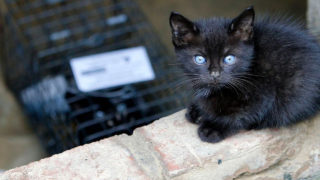Characteristics
| Weight: | 440-470 grams/15.5-16.6 ounces |
|---|---|
| Teeth: | Canines and incisors in |
| Eyes: | Blue |
| Ears: | Fully upright |
Behavior
Once kittens grow past four weeks, they’re no longer considered neonatal. If you’ve been raising the kittens for a few weeks already, congratulations—the hardest part is over! Kittens at this age are steady on their feet and hold their tails up. They will start to explore their surroundings more and play frequently with each other, toys, and people.
As an important milestone, kittens of this age will start weaning. That means they’ll slowly start to eat solid food so they no longer rely on you or their mother cat to feed them. This age is also great for litter box training.
Care
Feeding
When kittens are four weeks old, it’s time to start getting serious about the weaning process! Mix kitten formula with wet food and either let the kittens eat it themselves from a dish or feed them the mixture with a kitten-specific bottle. Gradually, adjust the mixture so it’s more wet food and less formula. Once the kittens can eat wet food, start mixing formula with dry food, too. When the kittens are eating solid food like this, make sure you always provide them with water.
When you are bottle feeding, feed kittens on their stomachs—not their backs—and tilt the bottle. After they’re done eating, you need to burp the kittens. Put them on your shoulder or on their stomachs and pat them gently until they burp. Clean kittens using a warm, damp washcloth after you feed them.
Feeding frequency:
Two or three times a day, like an adult cat!
Bedding:
Kittens can regulate their own body temperature at four to five weeks old, but you should still provide a source of heat that they can go to as needed. They will most likely be roaming from the nest at this point because they want to explore.
Bathroom habits:
Start litter box training, if you haven’t already. Provide the kittens with a small, shallow litter pan with non-clumping litter. Show kittens the litter box and they should quickly start using it out of instinct. To help them out, put in one of the cotton balls that you used to help them urinate.
For more on caring for kittens younger than four weeks old, including health concerns, go to Caring for Neonatal Kittens.
Socialization
Handle the kittens often at this age to encourage their social development. This helps them connect positive experiences with people, which will help to adopt them into new homes. Kittens of this age show interest in their surroundings and interact with their littermates, people, and toys. You can socialize them through:
Food:
Food is a great tool to socialize kittens. When you feed the kittens wet food, stay in the room so they associate you with food and start to trust you. Over time, move the food plate closer to your body while you sit in the room, until the plate is in your lap and the kittens are comfortable crawling on you to get to it.
Pet the kittens while they’re eating so they stay put and build up to holding the kittens, rewarding them with some canned cat food. Don’t allow the kittens to play with your hand or bite or scratch youit will teach kittens that biting is OK.
Playing:
Playing is an important part of kitten socialization because it helps them bond with each other and build confidence around people. Play with kittens for at least two hours a day (all together or broken up). Take time to socialize each of the kittens in a litter individually. At this age, kittens will love to play with toys and you should encourage that!
For more about socializing kittens, visit alleycat.org/Socialization.

